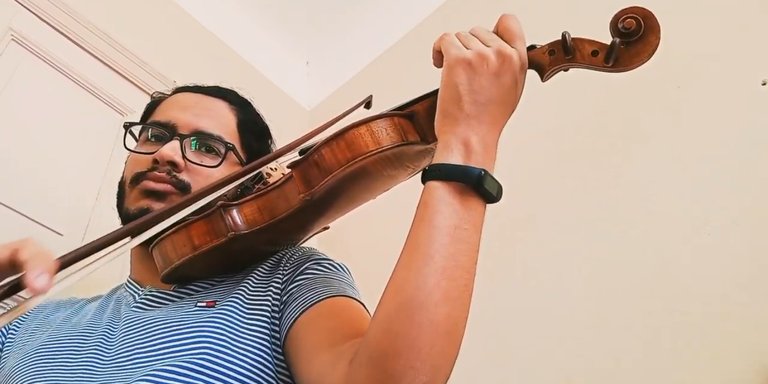El trabajo detrás de un violinista / The work behind a violinist

Hola queridos y apreciados amigos / lectores, espero estén de lo mejor en estas fechas tan especiales
Para ir terminando el año me llegó una idea bastante particular de un post, que surge básicamente porque en la música mayormente se muestra una cara de la moneda, siendo así en todas las artes y deportes...
El actor nos muestra la escena en un espectáculo, el beisbolista nos muestra su talento en el juego, la orquesta interpreta una obra en em concierto... Pero, y detrás de todo ese trabajo ¿que hay?
Pues es una pregunta difícil, pero que básicamente se resume a trabajo duro. Estudio duro.
Trabajo duro y estudio duro porque un artista está en constante aprendizaje, cómo todos nosotros en nuestras áreas.
Como dije antes, el beisbolista nos muestra el talento en el juego, pues el juego es lo "visible", por darle un nombre, y en un músico pasa lo mismo, pero en los conciertos...
Pero lo curioso es que el músico no se estudia la partitura o la obra un dia antes, ni se la lee en pleno concierto (a menos que sea una improvisación), pues el músico estudia y trabaja una obra... Y es por ello que quise traerles un poco de eso que las personas no tienen la dicha de ver:
En este fragmento estoy estudiando un capricho de un método bastante bueno y complicado para Violín, donde tengo que primero estudiar la afinación, pues en este capricho es muy pero muy fácil desafinar.
¿Como estudio esa afinación? Pues lento, en acordes, con notas separadas y comparando. Básicamente en los instrumentos cómo el violin, cello, viola y contrabajo (y otros, pero estos son los más comunes) es bastante difícil de afinar, ¿adivina por qué? Pues porque no tiene trastes como la guitarra o como el cuatro. Y tampoco teclas como el piano.
La afinación basicamente está en el oido de quien lo interpreta, eso lo hace complicadísimo. Y justo en el video notarán como a veces se escucha raro, desafinado, y precisamente porque el dedo lo voy moviendo muy mínimo, para ir buscando la afinación.
Y aquí, cómo comparación, de un fragmento más largo de la obra, aún en tiempo lento:
Asi que esperando que éste post les haya sido interesante, me despido. ¡Les mando un abrazo fuerte!

Hello dear and dear friends / readers, I hope you are doing the best on these special dates
To finish the year, I got a very particular idea from a post, which arises basically because in music mostly one side of the coin is shown, being this way in all arts and sports ...
The actor shows us the scene in a show, the baseball player shows us his talent in the game, the orchestra plays a work in concert ... But what is behind all that work?
Well, it's a difficult question, but one that basically boils down to hard work. I study hard.
I work hard and study hard because an artist is constantly learning, like all of us in our areas.
As I said before, the baseball player shows us the talent in the game, because the game is the "visible", to give it a name, and the same thing happens in a musician, but in concerts...
But the funny thing is that the musician does not study the score or the work a day before, nor read it in full concert (unless it is an improvisation), because the musician studies and works on a work ... And that is why I wanted to bring you a little of what people are not happy to see:
In this fragment I am studying a quirk of a fairly good and complicated method for Violin, where I have to first study the tuning, because in this quirk it is very, very easy to detune.
How do I study that tuning? Well, slow, in chords, with separate notes and comparing. Basically on instruments like violin, cello, viola and double bass (and others, but these are the most common) it is quite difficult to tune, guess why? Well, because it doesn't have frets like a guitar or a four. And not keys like the piano.
The tuning is basically in the ear of the person who plays it, that makes it very complicated. And right in the video you will notice how sometimes it sounds strange, out of tune, and precisely because my finger is moving very slightly, to go looking for the tuning.
And here, as a comparison, of a longer fragment of the work, still in slow time:
So hoping that this post has been interesting to you, I say goodbye. I send you a big hug!
Curador: @Mariale07
Te invitamos a visitar nuestro servidor en Discord
Congratulations @gregorior! You have completed the following achievement on the Hive blockchain and have been rewarded with new badge(s) :
You can view your badges on your board and compare yourself to others in the Ranking
If you no longer want to receive notifications, reply to this comment with the word
STOPDo not miss the last post from @hivebuzz:
Resteemed, your post will appear in the next curation post with a share for you!
Your post has been supported and upvoted from the Classical Music community (Subscribe at peakd and Steempeak) as it appears to be of interest to our community. We also support jazz and folk music posts!
If you enjoy our support of the #classical-music community, please consider a small upvote to help grow the support account!
You can find details about us below.
The classical music community at #classical-music, Peakd, Steempeak and Discord. Follow our community accounts @classical-music and @classical-radio or follow our curation trail (classical-radio) at Hive Vote or SteemAuto!